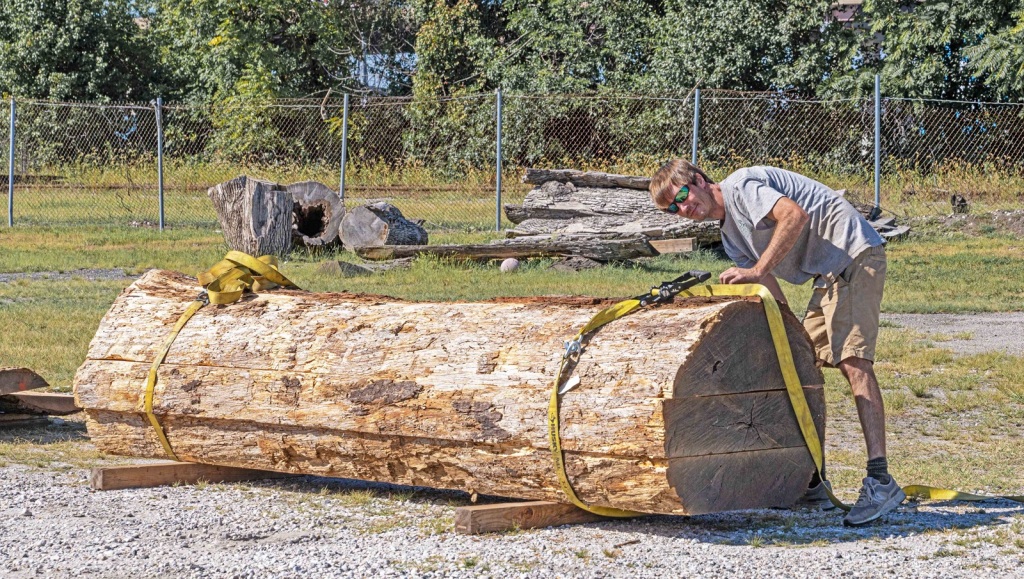
(This article originally appeared in the December 2023 issue of the South Baltimore Peninsula Post newspaper.)
Sandtown Furniture is a handmade furniture operation that prides itself on sourcing its materials from the heart of Baltimore. The SoBo-born company focuses on creating high-quality, long-lasting custom furniture from local reclaimed wood. They create a wide variety of products, from residential furnishings such as coffee tables, mantels, and barn doors, to commercial products such as conference tables and restaurant benches. Sandtown woodworkers also craft smaller goods including cutting boards and desk organizers.
The company’s operation consists of two locations: the recently opened production space and gallery on Wicomico Street and its sawmill at Impact Village on W. Dickman Street in the Baltimore Peninsula area (formerly Port Covington), which opened in 2016. We interviewed cofounder Will Phillips at the sprawling Impact Village warehouse amid endless stacks of tree trunks and planks, huge saws, and sawdust.
Phillips cofounded the company in 2010 out of what he humbly describes as a pile of timber and rubble during a Habitat for Humanity volunteer event in West Baltimore. He thought that the piles of timber – some planks were over 100 years old – were too valuable to go to waste, so he hauled them away instead of throwing them in the dumpster. The beams were in great condition, so it was a no brainer, he said, that they could be made into high-quality furniture.
Originally Phillips partnered with SoBo-based architect and maker John Bolster, who runs New Renaissance Builders. Friend and designer James Battaglia joined shortly afterwards, and they’ve been working together ever since. They opened their first location on Belt Street in the Riverside neighborhood as “Sandtown Millworks.”
While initially, Sandtown worked mostly with discarded beams from razed rowhouses and other Baltimore buildings, around 2018 they started working with Camp Small, a zero-waste wood collection yard run by the Baltimore Department of Recreation and Parks. The department’s Forestry Division founded the Camp Small Zero Waste initiative in 2016 to sort and distribute many types of reclaimed wood at its Jones Falls valley site and make it available for area residents and businesses to purchase.

Enter Sandtown Furniture, which eagerly began to purchase logs to add to its furniture-making efforts. Up until then, Sandtown had primarily been using salvaged pine beams, but thanks to this new cache of wood, they moved ahead with the goal of using 50 percent pine wood and 50 percent other types of wood, primarily white oak, ash, and walnut. Including the reclaimed rowhouse beams, the Camp Small wood yard, and felled trees from a few local arborists, all of the wood sourced for Sandtown Furniture comes from Baltimore.
Once the wood is claimed, it’s sawed into lumber with one of two saws at the mill. A forklift operator positions the trunks and the blade, guided by a technician, saws into the wood horizontally. One saw produces slab wood which can be used for tabletops. The other saw produces dimensional wood, beams of different sizes for a variety of uses. Felled trees that are sawed into slab wood retain their bark on the sides for a rustic look.
Then the planks and beams are stacked in the warehouse, with spacers in between each piece to evenly distribute the weight and prevent warping. Once stacked, they are left alone to dry, anywhere from three months to three years. Phillips can assess the levels of moisture via a moisture meter, or a small pin he sticks in the wood. After the wood is deemed ready, it gets a final drying in a vacuum kiln before it is brought over to the production workshop to be joined into furniture.

Sandtown’s workshop is in a 140-year-old warehouse on Wicomico Street with 32,000-square-feet of floor space that Phillips and Battaglia bought in 2021. The abandoned structure underwent a year and a half of renovations before opening to the public in January 2023.
The production process varies greatly item to item, as every order is custom made and no two orders are the same. The production team is small – eight people in all – but they crank out orders at a breakneck pace. They handle from 500 to 1000 orders a year.
Battaglia starts with SketchUp software to handle some aspects of the design, but many of the design decisions rely on the skills and experience of the woodworkers. With the wood selected, pieces are joined by hand with steel from DS Steel, a Pigtown pipe and supply company. After the assembled piece is stained and other finishing touches applied, it is ready to ship. The entire crafting process can take up to 12 weeks, but with all hands on deck, projects can be completed in as little as three weeks. Most of Sandtown’s work goes to customers in the DMV area.
The company represents Baltimore through and through and has collaborated with other local businesses and individuals. When the Peninsula Post toured the sawmill in September, we watched white oak planks being sawed into staves for Sagamore Spirit’s whiskey barrels. They have also incorporated some of the artwork of local artist Kelly Walker into their limited-edition pieces. Phillips remarked that Walker is one of “Baltimore’s biggest advocates and brings such a collaborative energy to the design process.”
Their Wicomico Street location, dubbed Sandtown HQ2, doubles as a showroom and gallery with vaulted ceilings, exposed brick, and lots of natural light. The space is so large and attractive that they rent their 7,000 square foot event venue known as The “Butterfly Room” -upon request. They’ve held the Bmore Flea flea market there as well as Baltimore’s CreativeMornings, a monthly breakfast lecture series. It’s also a popular wedding venue.
To find out how you can order a custom piece of furniture or book the showroom for an event, make an appointment on their website. – John Thomas
